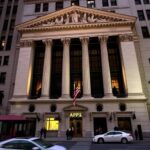In a closely watched move, the Federal Reserve announced on Wednesday that it would hold interest rates steady at the current range of 5.25% to 5.50%, opting for caution amid ongoing inflation pressures and mixed signals on economic growth. This decision, which came after two days of deliberations by the Federal Open Market Committee (FOMC), underscores the central bank’s delicate balancing act between taming price increases and supporting a resilient yet uncertain economy.
Chair Jerome Powell, in his post-meeting press conference, emphasized the need for more data before any adjustments. “Inflation remains elevated, and while we’ve made progress, it’s not yet sustainably moving toward our 2% target,” Powell stated. The Fed’s benchmark rate has been unchanged since July 2023, following a series of aggressive hikes that peaked at over five percentage points to combat post-pandemic inflation surges.
The announcement rippled through financial markets, with the S&P 500 dipping slightly by 0.3% in after-hours trading, reflecting investor expectations of stability but also wariness about prolonged high rates. Bond yields held firm, as traders parsed the Fed’s updated economic projections, which now forecast slower economic growth at 2.1% for 2024, down from earlier estimates of 2.5%.
Fed Officials Grapple with Persistent Inflation Metrics
The Federal Reserve‘s decision to keep interest rates unchanged is deeply rooted in recent inflation data that refuses to cool as quickly as hoped. The Consumer Price Index (CPI) rose 3.2% year-over-year in the latest report, a slight uptick from the previous month’s 3.1%, driven by stubborn increases in housing costs and energy prices. Core inflation, excluding volatile food and energy, clocked in at 3.4%, highlighting the persistence of underlying price pressures.
Policymakers at the Fed have been laser-focused on these metrics since inflation first spiked to 9.1% in June 2022, the highest in four decades. The central bank’s preferred gauge, the Personal Consumption Expenditures (PCE) price index, showed a 2.7% annual increase in November 2023, still well above the 2% goal. “We are not seeing the disinflationary process accelerate as we would like,” noted Fed Governor Lisa Cook during the FOMC meeting, according to minutes released later.
Geopolitical tensions, including the ongoing conflicts in Ukraine and the Middle East, have exacerbated supply chain disruptions, pushing up commodity prices and complicating the inflation outlook. Oil prices, for instance, have hovered around $75 per barrel, influenced by OPEC+ production cuts and Red Sea shipping attacks. These external factors have led Fed economists to revise their inflation projections upward to 2.5% for the end of 2024, from a previous 2.3%.
Internally, the FOMC discussions revealed a divide: while some members advocated for potential rate cuts as early as mid-2024 if data improves, a majority expressed caution, citing risks of reigniting inflation if easing comes too soon. This internal debate was evident in the dot plot, where the median projection now anticipates just two quarter-point cuts in 2024, fewer than the three signaled in December.
Impact on Economic Growth: A Slowdown Looms
As the Federal Reserve maintains its grip on interest rates, the ripple effects on economic growth are becoming more pronounced. The U.S. economy expanded at a 1.7% annualized rate in the fourth quarter of 2023, according to preliminary GDP estimates, a deceleration from the 4.9% surge in the third quarter. High borrowing costs have dampened consumer spending and business investment, key drivers of growth.
Housing, particularly sensitive to interest rates, has been hit hard. Mortgage rates, which track the 10-year Treasury yield influenced by Fed policy, remain above 7%, leading to a 20% drop in existing home sales year-over-year. The National Association of Realtors reported that inventory levels are still low, exacerbating affordability issues for first-time buyers and contributing to a broader slowdown in residential construction, which contracted by 1.2% in the latest month.
Businesses, facing elevated financing costs, have scaled back expansion plans. Corporate borrowing has slowed, with issuance of investment-grade bonds down 15% from 2022 peaks. Small businesses, often reliant on variable-rate loans, are feeling the pinch: the NFIB Small Business Optimism Index fell to 90.6 in December, below its historical average, with inflation cited as the top concern by 20% of owners.
Yet, the labor market provides a silver lining for economic growth. Unemployment held steady at 3.7% in December, with nonfarm payrolls adding 216,000 jobs, surpassing expectations. Wage growth moderated to 4.1% annually, easing some inflationary fears. Fed projections now see unemployment rising slightly to 4.1% by year-end, suggesting a soft landing remains possible if interest rates don’t strangle growth too tightly.
Regional disparities are emerging: while tech-heavy states like California benefit from AI-driven investments, manufacturing hubs in the Midwest report softening orders due to high rates curbing capital spending. Overall, the Fed’s steady policy aims to prevent a recession, but economists warn that prolonged uncertainty could shave 0.5 percentage points off GDP growth in 2024.
Market Reactions and Investor Strategies in Uncertain Times
Financial markets absorbed the Federal Reserve’s rate hold with measured responses, but underlying volatility signals investor jitters over the inflation and economic growth trajectory. The Dow Jones Industrial Average closed up 0.2% on the announcement day, buoyed by gains in financial stocks, while the Nasdaq Composite edged lower by 0.1%, pressured by tech sector concerns over sustained high interest rates.
Bond markets showed resilience, with the 10-year Treasury yield dipping to 4.05% post-announcement, as investors bet on the Fed’s data-dependent approach. However, the VIX fear index spiked 5% to 13.5, indicating heightened short-term uncertainty. “The Fed’s pause is a double-edged sword—stability for now, but delays in cuts could prolong the pain for growth-sensitive assets,” said Mohamed El-Erian, chief economic advisor at Allianz, in a Bloomberg interview.
Equity investors are shifting strategies: value stocks in sectors like energy and utilities outperformed growth counterparts, with the Russell 1000 Value Index gaining 1.2% in the week. Hedge funds have increased allocations to inflation-protected securities, such as TIPS, which saw inflows of $2.3 billion in the past month, per EPFR data. Cryptocurrencies, often viewed as inflation hedges, saw Bitcoin hover around $43,000, up 2% amid the news.
Globally, the decision influenced emerging markets, where currencies like the Brazilian real strengthened 1% against the dollar, anticipating similar central bank caution. European stocks, via the Stoxx 600, rose 0.4%, as the ECB’s parallel meeting echoed the Fed’s stance. For retail investors, apps like Robinhood reported a 10% uptick in queries about dividend stocks, as savers seek yield in a high-rate environment yielding 5% on money market funds.
Analysts from Goldman Sachs predict that if inflation eases to 2.5% by Q2, markets could rally 5-7%, but persistent pressures might lead to a 10% correction in equities. This environment has prompted diversified portfolios, with 60% of institutional investors surveyed by Morningstar planning to boost fixed-income exposure.
Expert Views: Balancing Act Between Inflation Control and Growth Support
Economic experts are divided on the Federal Reserve’s strategy of holding interest rates steady, with many praising the prudence while others urge more aggressive action to bolster economic growth. “The Fed is threading the needle—too soon to cut, but waiting too long risks tipping into recession,” opined Mark Zandi, chief economist at Moody’s Analytics, in a CNBC appearance. Zandi highlighted that core services inflation, at 4.5%, remains a sticky challenge, justifying the pause.
Conversely, critics like former Treasury Secretary Larry Summers argue the rates are overly restrictive. “Inflation is cooling faster than the Fed credits, and high rates are unnecessarily hurting economic growth,” Summers tweeted post-announcement, pointing to retail sales up 0.6% in December as evidence of consumer resilience.
From the academic side, Harvard economist Kenneth Rogoff noted in a recent paper that the neutral rate—where policy neither stimulates nor restricts growth—may have risen to 3-4% due to structural shifts like aging demographics and productivity gains from tech. This implies the current 5.25-5.50% range is only mildly tight, supporting the Fed’s wait-and-see approach.
International perspectives add nuance: IMF Chief Economist Pierre-Olivier Gourinchas warned that synchronized global rate pauses could amplify trade frictions, potentially slowing U.S. economic growth by 0.3% through export channels. Meanwhile, business leaders like JPMorgan CEO Jamie Dimon echoed the Fed’s caution, stating in his annual letter that “inflation uncertainty demands vigilance, even as growth holds up.”
Surveys underscore the split: A Reuters poll of 80 economists showed 55% approving the hold, with 70% expecting the first cut in June if CPI falls below 3%. This consensus reflects the Fed’s pivot toward monitoring wage-price spirals and supply-side improvements, like easing port congestion, which could accelerate disinflation.
Looking ahead, the path for interest rates hinges on upcoming data releases, including January’s jobs report and PCE figures. If economic growth softens further—say, GDP below 1.5% in Q1—pressure for cuts could mount. Conversely, renewed inflation spikes from events like tariff hikes under a potential new administration might force hikes, though most experts deem that unlikely.
For consumers, the steady rates mean mortgage refinancings remain costly, but credit card APRs stabilizing at 21% offer some relief. Businesses are advised to lock in fixed-rate debt now, per Deloitte recommendations, to shield against prolonged high interest rates. As the Fed continues its monitoring, the next FOMC meeting in March will be pivotal, with dot plot updates potentially signaling the timing of rate relief and its implications for sustained economic growth.








